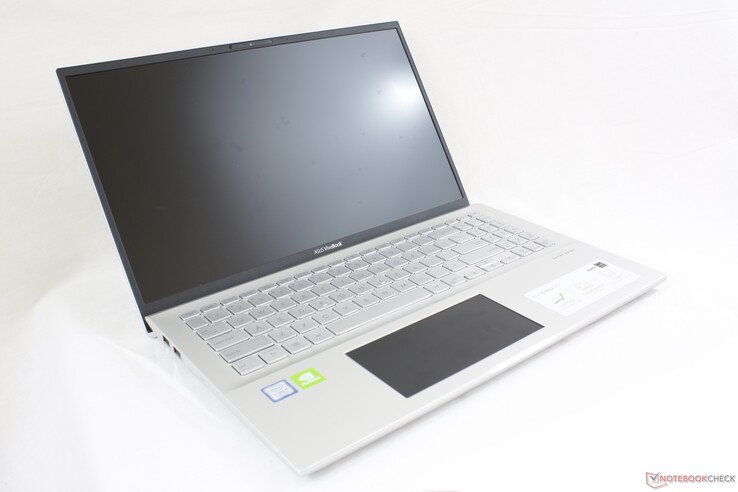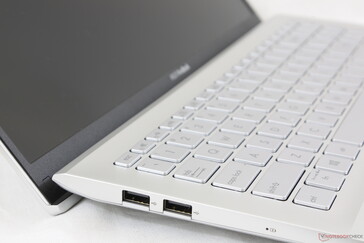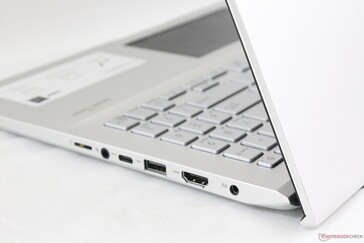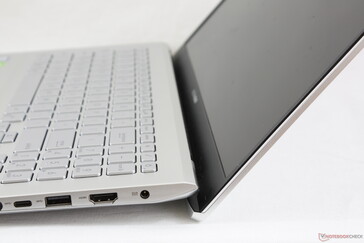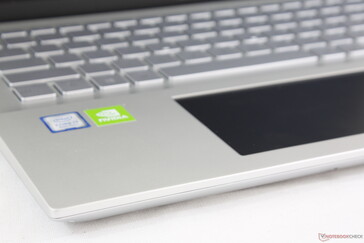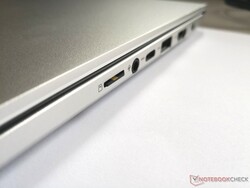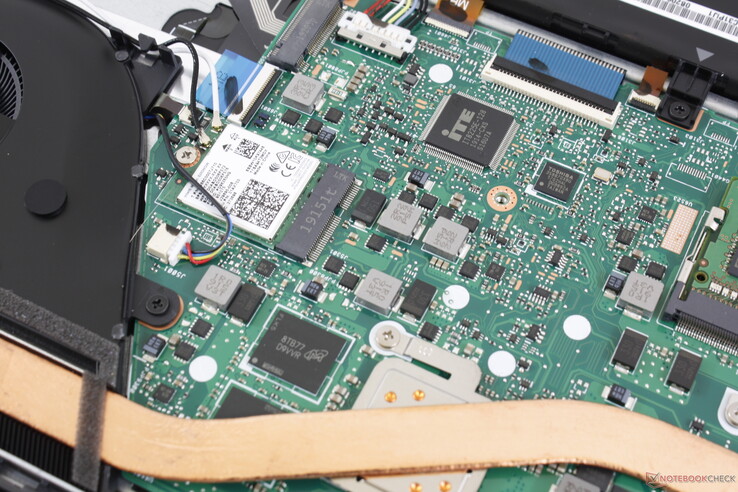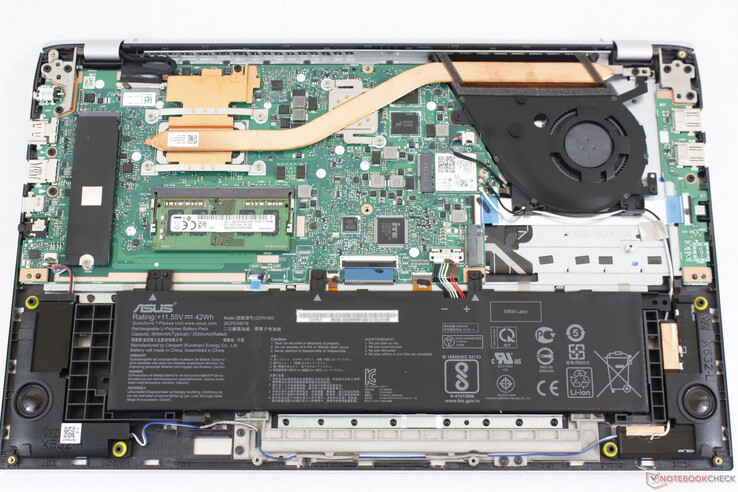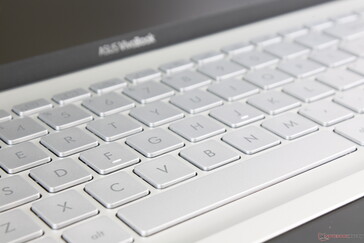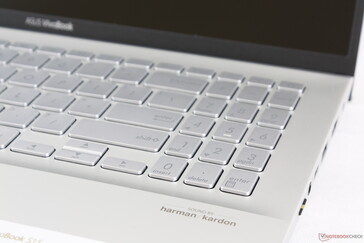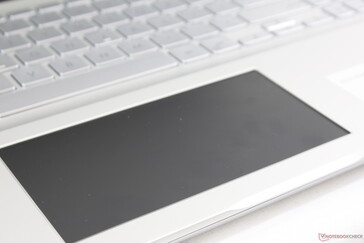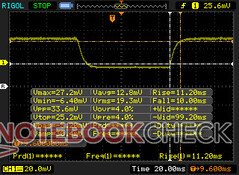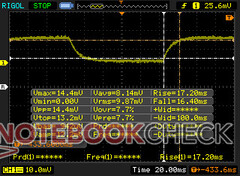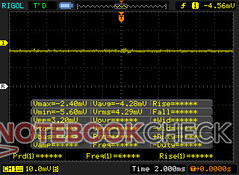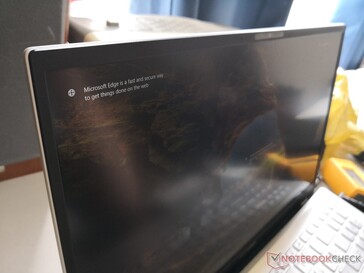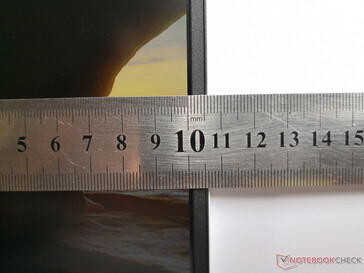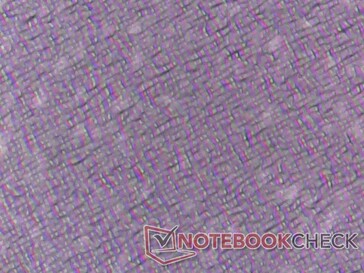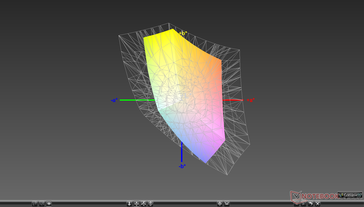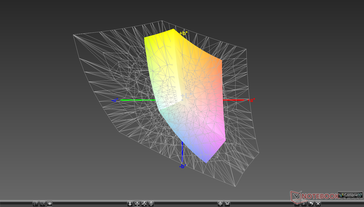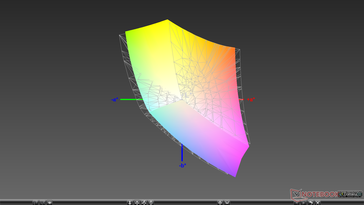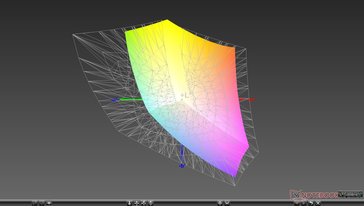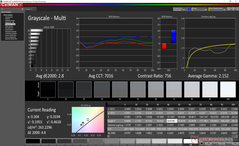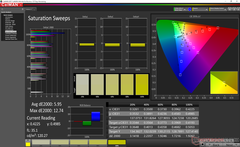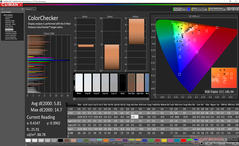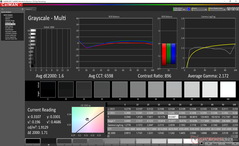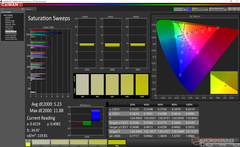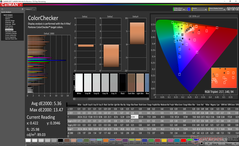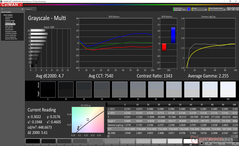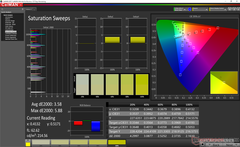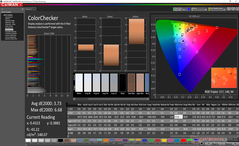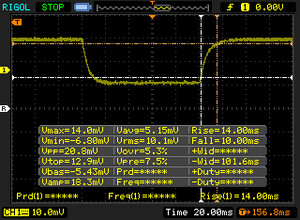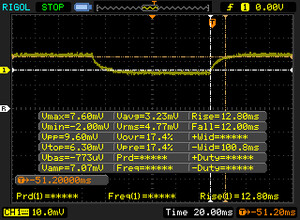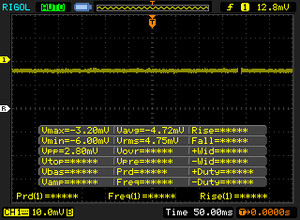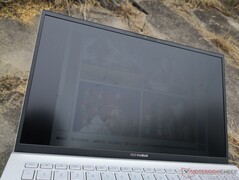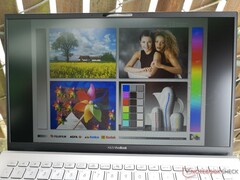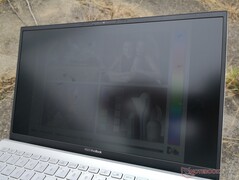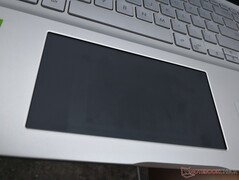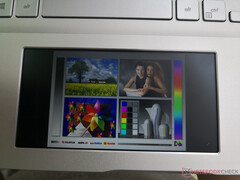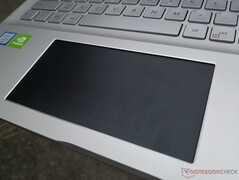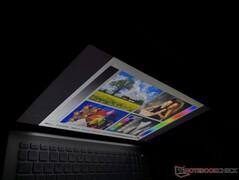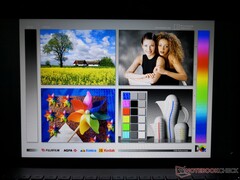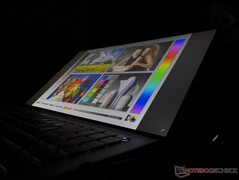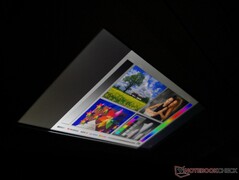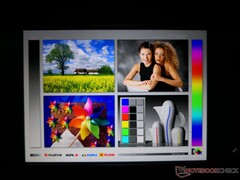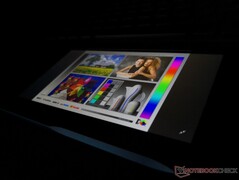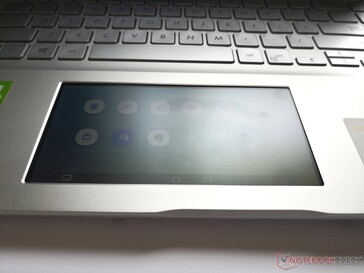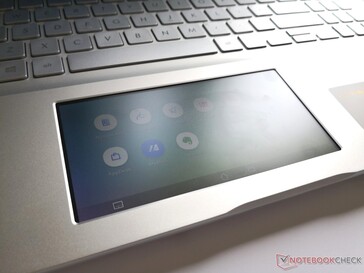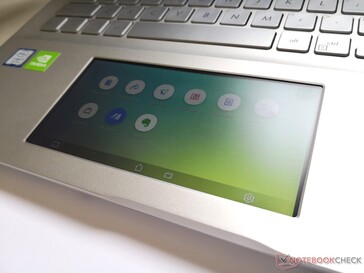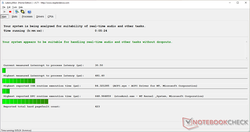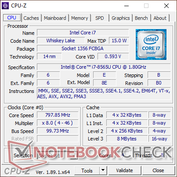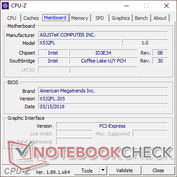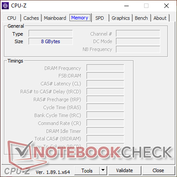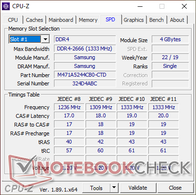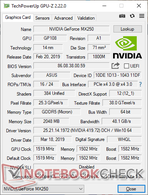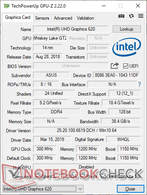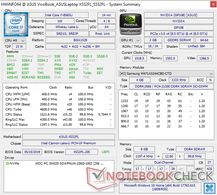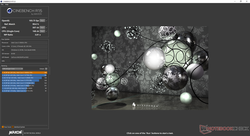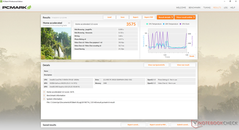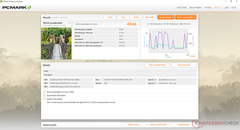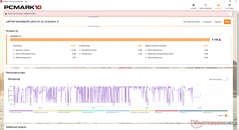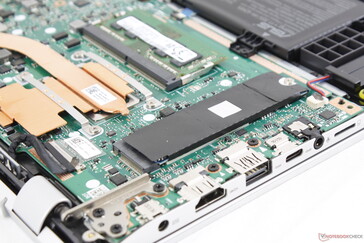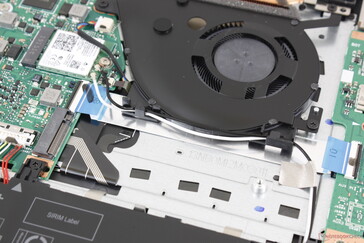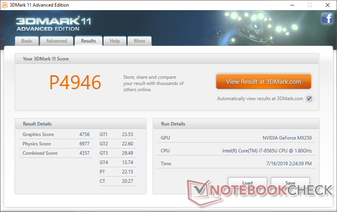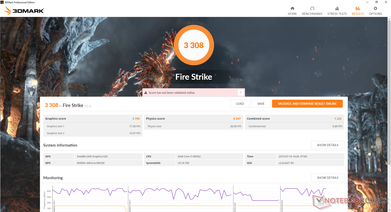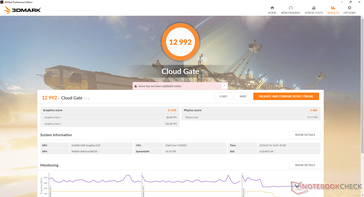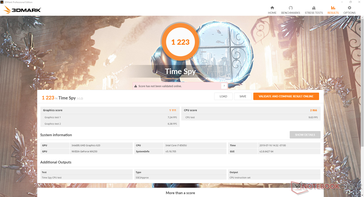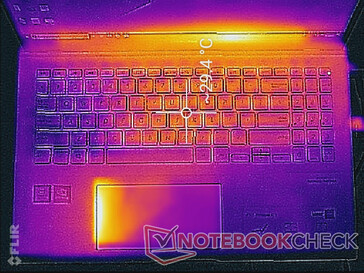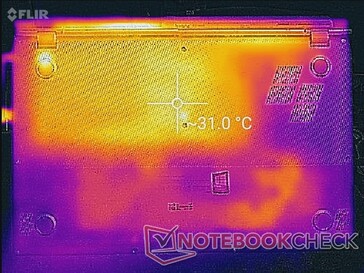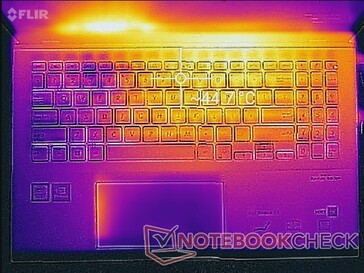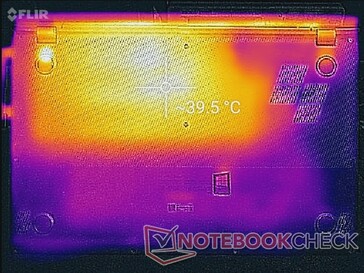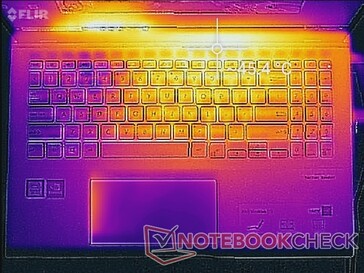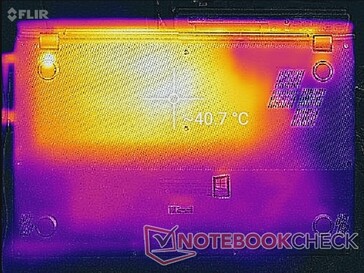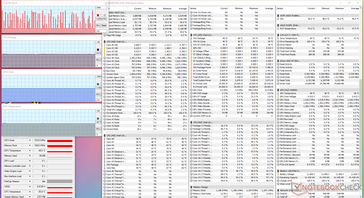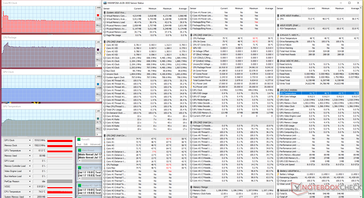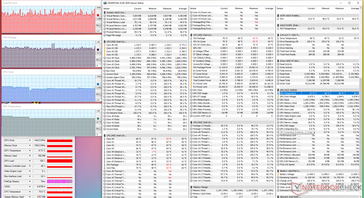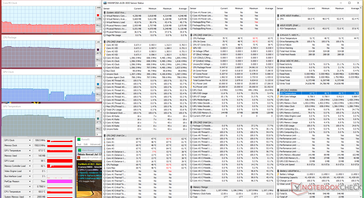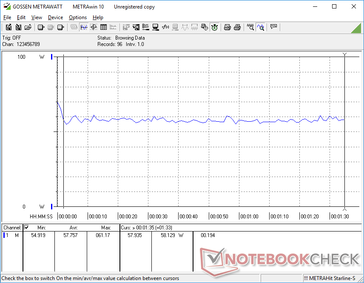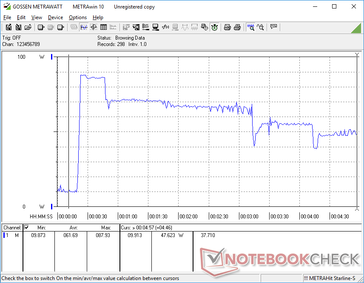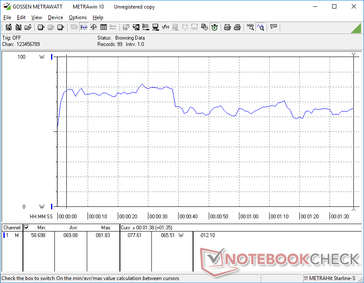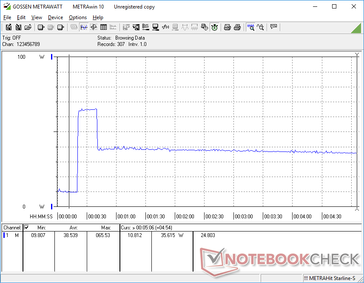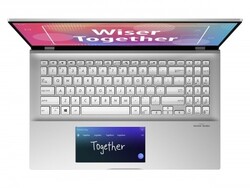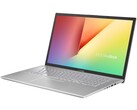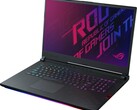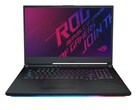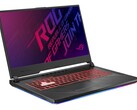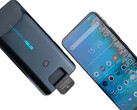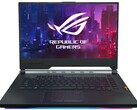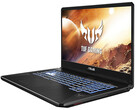ScreenPad 2.0 Debut: Asus VivoBook S15 S532FL Laptop Review
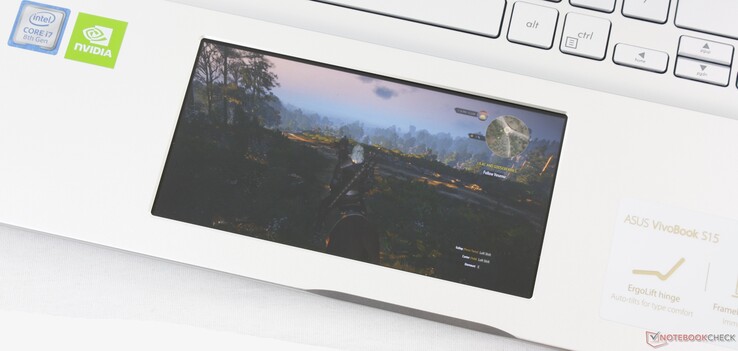
Asus introduced its first generation Screenpad 1.0 last year on the ZenBook Pro 15 UX580GE The system was essentially a ZenBook Pro 15 UX550 but with the traditional clickpad swapped for a ScreenPad instead. Fast-forward to 2019 and Asus is now ready to introduce its second generation Screenpad to more laptops outside of just its flagship ZenBook series including the entry-level VivoBook series.
Our test unit today is the VivoBook S15 S532 which is essentially the VivoBook S15 S531 but with the traditional clickpad swapped for a ScreenPad 2.0. Port positioning is also slightly different this time around which we will detail below. Other than the small list of changes, the chassis is identical to the S531.
What we're most interested in is the 5.65-inch ScreenPad 2.0 and how it compares to last year's ScreenPad 1.0. Only two SKUs are available at the time of writing: the S532FL with i7-8565U CPU and GeForce MX250 graphics and the cheaper S532FA with i5-8265U CPU with integrated UHD Graphics 620. Both come equipped with the same Screenpad 2.0 touchscreen and 1080p display. Our test unit is the higher-end S532FL configuration with discrete Nvidia graphics for a respectable level of gaming performance considering the $800 USD asking price.
Direct competitors in this space are plentiful as there are many 15.6-inch Ultrabooks to choose from including the Dell XPS 15, Lenovo IdeaPad 720S, Acer Aspire 5 A515, or HP Spectre x360 15.
More Asus reviews:
Case
Although the chassis has changed from the VivoBook S15 S530, it doesn't feel all that different. The same matte plastic material is back for a more budget first impression when compared to the smoother brushed aluminum surfaces of the higher-end ZenBook 15 series. Even so, build quality is strong especially for the lid relative to other narrow bezel laptops like the LG Gram 15 or Samsung Notebook 9. Flexing is visible but minimal with just slight creaking when attempting to twist the base or depress the keyboard center.
The hinges are more of a mixed bag. We're able to notice quiet creaking noises when opening and closing the lid which adds to the "budget" feel of the design. The hinges could have been tauter as well especially when you get closer to the maximum angle of ~150 degrees where the hinges start to feel slightly weaker. They're satisfactory for now, but we have our doubts about longevity.
Footprint is slightly smaller than the last generation VivoBook S15 S530 since the bezels of the newer design are narrower. Otherwise, thickness and weight are unchanged. The system is only slightly larger than both the pricier ZenBook 15 UX533 and Dell XPS 15 9570.
Connectivity
We commend Asus for including three USB Type-A ports which is three more than what many other Ultrabooks tend to offer these days. Thunderbolt 3 is understandably omitted since the manufacturer is reserving this high-end feature for its costlier ZenBook series instead. It's too bad that the VivoBook series continues to rely on a proprietary AC adapter for charging instead of the more universal USB Type-C.
Port options are identical to the last generation VivoBook S15 S530 albeit slightly rearranged. The right edge in particular is now a bit more crowded with 6 of the 8 ports in close proximity to one another.
SD Card Reader
The spring-loaded MicroSD reader performs at about half the speed of the full-size SD reader on the ZenBook 15. Transferring 1 GB worth of images from our UHS-II test card to desktop takes about 31 seconds.
A fully inserted SD card sits almost flush against the edge for safe transporting.
| SD Card Reader | |
| average JPG Copy Test (av. of 3 runs) | |
| Dell XPS 15 9570 Core i9 UHD (Toshiba Exceria Pro SDXC 64 GB UHS-II) | |
| Lenovo IdeaPad S540-14API (Toshiba Exceria Pro SDXC 64 GB UHS-II) | |
| Lenovo Ideapad S340-14IWL-81N70056GE (Toshiba Exceria Pro SDXC 64 GB UHS-II) | |
| Asus ZenBook 15 UX533FD (Toshiba Exceria Pro SDXC 64 GB UHS-II) | |
| Lenovo Yoga 530-14ARR-81H9000VGE (Toshiba Exceria Pro SDXC 64 GB UHS-II) | |
| Asus VivoBook S15 S532F (Toshiba Exceria Pro UHS-II) | |
| maximum AS SSD Seq Read Test (1GB) | |
| Dell XPS 15 9570 Core i9 UHD (Toshiba Exceria Pro SDXC 64 GB UHS-II) | |
| Lenovo IdeaPad S540-14API (Toshiba Exceria Pro SDXC 64 GB UHS-II) | |
| Lenovo Ideapad S340-14IWL-81N70056GE (Toshiba Exceria Pro SDXC 64 GB UHS-II) | |
| Asus ZenBook 15 UX533FD (Toshiba Exceria Pro SDXC 64 GB UHS-II) | |
| Lenovo Yoga 530-14ARR-81H9000VGE (Toshiba Exceria Pro SDXC 64 GB UHS-II) | |
| Asus VivoBook S15 S532F (Toshiba Exceria Pro UHS-II) | |
Communication
An Intel 8265 comes standard for transfer rates up to 867 Mbps and integrated Bluetooth 4.2. In contrast, most Ultrabooks these days come equipped with the pricier Intel 9260 or 9560 for transfer rates up to 1.73 Gbps and integrated Bluetooth 5. For home and office purposes, the Intel 8265 is more than sufficient. We experienced no connectivity issues during our time with the test unit.
Maintenance
Servicing requires a Philips screwdriver and a sharp edge. The bottom panel is latched very tightly around the edges and corners — much more so than on most other laptops we've tested. Be very careful to not damage the system or your fingers during this process.
Users will get direct access to 2x storage bays and 1x SODIMM slot.
Accessories and Warranty
There are no included extras in the box outside of the usual warranty card and Quick Start guide. The standard one-year limited warranty applies.
Input Devices
Keyboard
The keyboard is identical to the keyboard of the VivoBook S15 S530 despite the changes to the chassis. Key sizes, layout, and tactility are thus unchanged meaning our existing comments still apply here.
An annoying attribute of the keyboard worth repeating is the white color of the key caps. Since the backlight is also white, the contrast is poor when compared to the usual black key caps with white lighting. White Samsung laptops have avoided this issue by using a blue backlight instead and so it's disappointing to see no improvements from Asus in this regard.
Touchpad
If you already have a dual monitor setup at home or work, then you are already familiar with Asus' ScreenPad as it is essentially a 5.65-inch (13 x 6.7 cm) secondary IPS monitor with a native resolution of 2160 x 1080. Everything you can do on a typical multi-monitor PC setup can also be done on the ScreenPad including video, wallpaper settings, brightness, and even gaming. The practicality of the feature is obvious for both multimedia and productivity.
The ScreenPad has its own unique settings menu as well. Unlike last year's ScreenPad, frame rates are silky smooth this time around with an Android-like UI to make navigation feel more familiar even for first-time users. Brightness, resolution, and refresh rates can be adjusted. Customizeable shortcuts are available for launching Windows or ScreenPad applications much like on an Android Home screen.
An annoying feature of the ScreenPad is the automatic pop-up that suddenly appears when dragging a window on the main display. The pop-up will help snap the window you're dragging to the ScreenPad, but the problem is that it's very easy to accidentally snap the window if all you want to do is move it by just half an inch.
If you're uninterested in the ScreenPad and only wish to use it as a traditional clickpad, then you only need to press the clickpad icon on the bottom left with a finger to enable traditional clickpad mode. Gliding on the slightly roughened matte surface feels a lot like a regular clickpad but just a tad bit stickier.
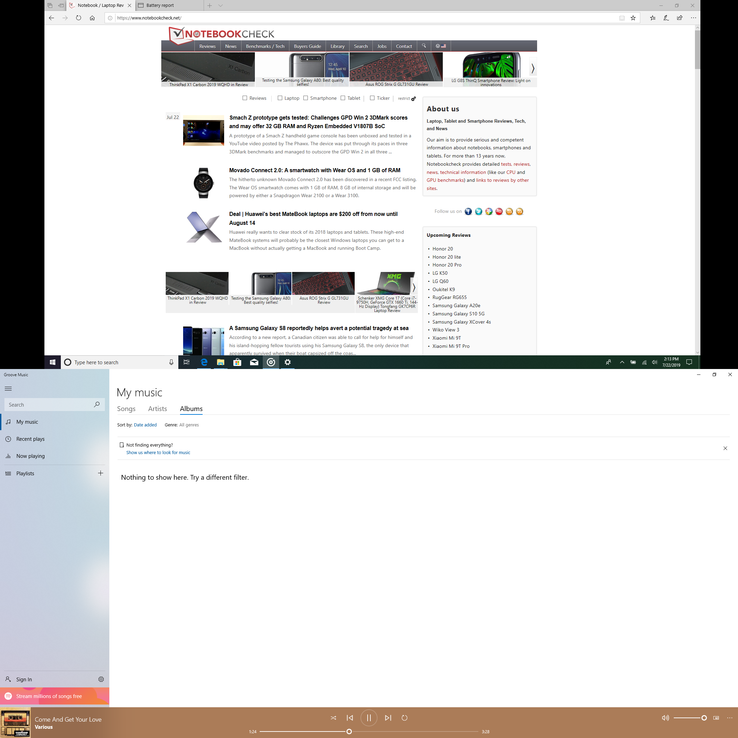
Display
The S532 utilizes the exact same LG Philips LP156WFC-SPD1 IPS panel as on the S530 and so our existing comments on the S530 display apply here. Both color space and contrast are only average for shallower and less accurate colors than on Asus' pricier ZenBook 15 UX533.
Perhaps most notably, the ScreenPad is brighter than the main display (450 nits vs. 262 nits) with higher native resolution (2160 x 1080 vs. 1920 x 1080), higher contrast ratio (~1100:1 vs. ~600:1), and even a wider gamut (89.7 percent sRGB vs. 55.6 percent sRGB). Subjectively, however, these advantages mean little because the matte overlay on the ScreenPad causes onscreen text and images to appear very grainy. It's not as bad as on the first generation ScreenPad, but it's noticeable nonetheless.
| ScreenPad 2.0 | |
|---|---|
| Response Time Grey 50%/Grey 80% (ms) | 17.2, 16.4 |
| Response Time Black/White (ms) | 11.2, 10.0 |
| Brightness (nits) | 450.8 |
| Black Level (nits) | .39 |
| Contrast | 1156:1 |
| ColorChecker DeltaE2000 | 3.73 |
| ColorChecker DeltaE2000 Max | 6.68 |
| Greyscale DeltaE2000 | 4.7 |
| Gamma | 2.26 |
| CCT | 7540 |
| Color Space (% of AdobeRGB 1998) | 57.7 |
| Color Space (% of sRGB) | 89.7 |
| |||||||||||||||||||||||||
Brightness Distribution: 89 %
Center on Battery: 262.3 cd/m²
Contrast: 610:1 (Black: 0.43 cd/m²)
ΔE ColorChecker Calman: 5.81 | ∀{0.5-29.43 Ø4.77}
calibrated: 5.36
ΔE Greyscale Calman: 2.8 | ∀{0.09-98 Ø5}
55.6% sRGB (Argyll 1.6.3 3D)
35.2% AdobeRGB 1998 (Argyll 1.6.3 3D)
38.35% AdobeRGB 1998 (Argyll 3D)
55.9% sRGB (Argyll 3D)
37.12% Display P3 (Argyll 3D)
Gamma: 2.15
CCT: 7016 K
| Asus VivoBook S15 S532F LG Philips LP156WFC-SPD1, IPS, 15.6", 1920x1080 | Dell XPS 15 9570 Core i9 UHD LQ156D1, IPS, 15.6", 3840x2160 | HP Envy x360 15-bq102ng Chi Mei CM15E9, IPS, 15.6", 1920x1080 | Asus ZenBook 15 UX533FD BOE07D8, IPS, 15.6", 1920x1080 | Acer Aspire 5 A515-52G-723L BOE NV156FHM-N48, IPS, 15.6", 1920x1080 | Asus VivoBook S15 S530UN-BQ097T LP156WFC-SPD1, IPS LED, 15.6", 1920x1080 | |
|---|---|---|---|---|---|---|
| Display | 99% | 11% | 69% | 7% | 4% | |
| Display P3 Coverage (%) | 37.12 | 79.6 114% | 41.36 11% | 67.2 81% | 40.02 8% | 38.51 4% |
| sRGB Coverage (%) | 55.9 | 98.4 76% | 62.2 11% | 88.4 58% | 58.5 5% | 57.9 4% |
| AdobeRGB 1998 Coverage (%) | 38.35 | 79.7 108% | 42.74 11% | 64.6 68% | 41.34 8% | 39.79 4% |
| Response Times | -72% | -35% | -68% | -60% | -34% | |
| Response Time Grey 50% / Grey 80% * (ms) | 24.8 ? | 52.4 ? -111% | 40 ? -61% | 45 ? -81% | 45 ? -81% | 38.8 ? -56% |
| Response Time Black / White * (ms) | 24 ? | 31.6 ? -32% | 26 ? -8% | 37 ? -54% | 33 ? -38% | 26.8 ? -12% |
| PWM Frequency (Hz) | 1000 ? | 25000 ? | 250 ? | |||
| Screen | 28% | 34% | 31% | 19% | 18% | |
| Brightness middle (cd/m²) | 262.3 | 451.9 72% | 221 -16% | 311 19% | 278 6% | 262 0% |
| Brightness (cd/m²) | 250 | 414 66% | 207 -17% | 303 21% | 271 8% | 256 2% |
| Brightness Distribution (%) | 89 | 81 -9% | 87 -2% | 81 -9% | 89 0% | 90 1% |
| Black Level * (cd/m²) | 0.43 | 0.36 16% | 0.15 65% | 0.24 44% | 0.26 40% | 0.21 51% |
| Contrast (:1) | 610 | 1255 106% | 1473 141% | 1296 112% | 1069 75% | 1248 105% |
| Colorchecker dE 2000 * | 5.81 | 5.62 3% | 4.35 25% | 5.1 12% | 4.73 19% | 5.8 -0% |
| Colorchecker dE 2000 max. * | 14.7 | 19.1 -30% | 8.98 39% | 8.91 39% | 8.38 43% | 14.3 3% |
| Colorchecker dE 2000 calibrated * | 5.36 | 2.69 50% | 2.48 54% | 5.17 4% | 4.6 14% | |
| Greyscale dE 2000 * | 2.8 | 6.9 -146% | 3.09 -10% | 4.93 -76% | 2.59 7% | 2.5 11% |
| Gamma | 2.15 102% | 2.2 100% | 2.23 99% | 2.44 90% | 2.38 92% | 1.99 111% |
| CCT | 7016 93% | 6254 104% | 6068 107% | 7641 85% | 6160 106% | 6528 100% |
| Color Space (Percent of AdobeRGB 1998) (%) | 35.2 | 71.8 104% | 56 59% | 58 65% | 36 2% | 36.6 4% |
| Color Space (Percent of sRGB) (%) | 55.6 | 98.5 77% | 86 55% | 88 58% | 58 4% | 57.6 4% |
| Total Average (Program / Settings) | 18% /
29% | 3% /
20% | 11% /
26% | -11% /
7% | -4% /
9% |
* ... smaller is better
Color space for the main display is narrow at just 55.6 percent of sRGB compared to >90 percent on most flagship Ultrabooks. This is definitely not the system to use for any professional graphics work. It's very odd to find that the secondary ScreenPad is capable of reproducing a wider range of colors than the primary display.
Color temperature is slightly on the cool side for the main display. Our calibration attempt addresses this for a more accurate grayscale, but color accuracy remains moot due to the very narrow color space mentioned above.
Meanwhile, color temperature on the ScreenPad is far too cool. While it's possible to calibrate the ScreenPad for even better colors, the VivoBook series is not designed to provide color accurate displays in the first place and so the practicality of calibrating the ScreenPad is questionable.
Display Response Times
| ↔ Response Time Black to White | ||
|---|---|---|
| 24 ms ... rise ↗ and fall ↘ combined | ↗ 14 ms rise | |
| ↘ 10 ms fall | ||
| The screen shows good response rates in our tests, but may be too slow for competitive gamers. In comparison, all tested devices range from 0.1 (minimum) to 240 (maximum) ms. » 53 % of all devices are better. This means that the measured response time is worse than the average of all tested devices (20.2 ms). | ||
| ↔ Response Time 50% Grey to 80% Grey | ||
| 24.8 ms ... rise ↗ and fall ↘ combined | ↗ 12.8 ms rise | |
| ↘ 12 ms fall | ||
| The screen shows good response rates in our tests, but may be too slow for competitive gamers. In comparison, all tested devices range from 0.165 (minimum) to 636 (maximum) ms. » 34 % of all devices are better. This means that the measured response time is better than the average of all tested devices (31.6 ms). | ||
Screen Flickering / PWM (Pulse-Width Modulation)
| Screen flickering / PWM not detected | |||
In comparison: 53 % of all tested devices do not use PWM to dim the display. If PWM was detected, an average of 8091 (minimum: 5 - maximum: 343500) Hz was measured. | |||
Outdoor visibility is only average at best. The main display is dimmer than both the XPS 15 and MacBook Pro 15 and so colors become washed out even if working under shade. Meanwhile, the ScreenPad is even worse because apparent brightness dips noticeably depending on the viewing angle. As shown by the images below, glare impacts the ScreenPad significantly and bright ambient light can even blacken the screen. The bright 450-nit backlight is only useful if looking directly at the ScreenPad from atop which is an unrealistic orientation during regular use.
Performance
The 15 W Intel U-class CPU puts the VivoBook S15 squarely in the Ultrabook category where such processors are ubiquitous. Instead, it's the discrete GeForce MX250 GPU option that sets our S532FA apart from most other Ultrabooks where graphics are typically limited to integrated Intel only. This gives our Asus significantly more graphics horsepower to play many popular titles at the native 1080p resolution.
There is 4 GB of soldered RAM with only one DDR4 SODIMM expansion slot. Thus, a maximum of 12 GB of DDR4-2400 RAM is supported.
It's worth noting that the S532 houses the faster '1D13' variant of the GeForce MX250 instead of the slower '1D52' variant as found on the Acer Swift 3. GPU Boost clock rates are much faster on the '1D13' variant (1582 MHz vs. 1038 MHz).
Processor
CPU performance is disappointing. CineBench R15 ranks the i7-8565U CPU in our VivoBook laptop 15 percent slower than the average i7-8565U laptop in our database. This becomes even worse after accounting for throttling as shown by our CineBench R15 Multi-Thread loop graph below. The initial score of 680 points falls off a cliff by the second loop to just 498 points to represent a steep performance dip of nearly 27 percent. The pricier ZenBook 15 with the same i7-8565U CPU is able to maintain a wide 39 percent lead over our VivoBook in the same benchmark. Even the Core i5-powered Lenovo Yoga C930 is able to outperform our Core i7-powered VivoBook.
Despite the below average processor performance, it's still about 15 percent and 50 percent faster than the two-generations old Core i7-7500U in single-thread and multi-thread loads, respectively. The performance benefits just aren't as wide as they could have been given what the i7-8565U is capable of on other laptops.
See our dedicated page on the Core i7-8565U for more technical information and benchmark comparisons.
| Cinebench R15 | |
| CPU Single 64Bit | |
| Asus ZenBook 15 UX533FD | |
| Average Intel Core i7-8565U (138.3 - 193, n=51) | |
| HP Omen 15-dc1020ng | |
| Lenovo Yoga C930-13IKB 81C4 | |
| Asus VivoBook S15 S532F | |
| Lenovo ThinkPad 13 20J1005TPB | |
| Lenovo IdeaPad S540-14API | |
| Lenovo Yoga C930-13IKB | |
| Lenovo Yoga 530-14ARR-81H9000VGE | |
| CPU Multi 64Bit | |
| Asus ZenBook 15 UX533FD | |
| HP Omen 15-dc1020ng | |
| Asus VivoBook S15 S532F | |
| Lenovo IdeaPad S540-14API | |
| Lenovo Yoga 530-14ARR-81H9000VGE | |
| Lenovo Yoga C930-13IKB 81C4 | |
| Lenovo Yoga C930-13IKB | |
| Average Intel Core i7-8565U (452 - 815, n=52) | |
| Lenovo ThinkPad 13 20J1005TPB | |
System Performance
PCMark benchmarks are consistently ahead of last year's VivoBook S530UN. Its Productivity Score, however, is 10 percent lower than the Acer Aspire 5 A515 equipped with the same CPU likely due in part to the below average CPU performance of our VivoBook. Navigation and browsing are still smooth as silk as one would expect from a modern SSD-powered Ultrabook.
| PCMark 8 Home Score Accelerated v2 | 3575 points | |
| PCMark 8 Work Score Accelerated v2 | 4946 points | |
| PCMark 10 Score | 4148 points | |
Help | ||
Storage Devices
Two M.2 2280 slots are available. Our test unit comes equipped with an entry-level 256 GB WDC PC SN520 with sequential read and write rates of about 1200 MB/s and 700 MB/s, respectively, according to AS SSD. Results are slow especially when compared to pricier NVMe drives like the Samsung SSD PM981, but even the slowest NVMe SSDs are almost always faster than the fastest SATA III-based SSDs where transfer rates are limited to about 500 MB/s.
See our table of HDDs and SSDs for more benchmark comparisons.
| Asus VivoBook S15 S532F WDC PC SN520 SDAPNUW-256G | Dell XPS 15 9570 Core i9 UHD Samsung SSD PM981 MZVLB1T0HALR | HP Envy x360 15-bq102ng Samsung PM961 MZVLW256HEHP | Lenovo Ideapad 720S-15IKB 81AC001AGE Samsung SSD PM981 MZVLB512HAJQ | Acer Aspire 5 A515-52G-723L WDC PC SN520 SDAPNUW-512G | |
|---|---|---|---|---|---|
| AS SSD | 71% | 1% | 102% | 34% | |
| Seq Read (MB/s) | 1147 | 1320 15% | 2465 115% | 2469 115% | 1557 36% |
| Seq Write (MB/s) | 752 | 1500 99% | 1318 75% | 1991 165% | 1237 64% |
| 4K Read (MB/s) | 41.52 | 30.73 -26% | 42.97 3% | 54.3 31% | 42.56 3% |
| 4K Write (MB/s) | 149.7 | 94.4 -37% | 81.9 -45% | 99.8 -33% | 127.2 -15% |
| 4K-64 Read (MB/s) | 605 | 1453 140% | 1025 69% | 1823 201% | 1034 71% |
| 4K-64 Write (MB/s) | 453.2 | 1815 300% | 338.6 -25% | 1282 183% | 1186 162% |
| Access Time Read * (ms) | 0.073 | 0.061 16% | 0.077 -5% | 0.042 42% | 0.077 -5% |
| Access Time Write * (ms) | 0.025 | 0.044 -76% | 0.046 -84% | 0.039 -56% | 0.028 -12% |
| Score Read (Points) | 761 | 1616 112% | 1314 73% | 2125 179% | 1233 62% |
| Score Write (Points) | 678 | 2059 204% | 552 -19% | 1581 133% | 1437 112% |
| Score Total (Points) | 1821 | 4507 148% | 2488 37% | 4771 162% | 3291 81% |
| Copy ISO MB/s (MB/s) | 1093 | 2577 136% | 700 -36% | 1313 20% | |
| Copy Program MB/s (MB/s) | 775 | 515 -34% | 167.2 -78% | 334.6 -57% | |
| Copy Game MB/s (MB/s) | 1196 | 1120 -6% | 370.4 -69% | 684 -43% |
* ... smaller is better
GPU Performance
The GeForce MX250 is merely a rebrand of the last generation MX150 and so there are almost no performance differences between them. 3DMark results are nearly identical to last year's Razer Blade Stealth equipped with the MX150. Users can expect a performance level in between the GTX 950M and GTX 960M.
3DMark scores are almost 25 percent higher than the Acer Swift 3 equipped with the same MX250 GPU. Nvidia offers two known variants of the MX250 with different clock rates and we're glad to see that the VivoBook utilizes the faster one.
| 3DMark 11 Performance | 4946 points | |
| 3DMark Cloud Gate Standard Score | 12992 points | |
| 3DMark Fire Strike Score | 3308 points | |
| 3DMark Time Spy Score | 1223 points | |
Help | ||
Gaming Performance
Much like the GeForce MX150 before it, the MX250 offers an excellent balance between gaming performance and portability. It's not powerful enough to play the most demanding titles at 1080p like Witcher 3 or Shadow of the Tomb Raider, but it's great for popular multiplayer titles like LoL, Fortnite, Overwatch, or Rocket League.
Running Witcher 3 shows no recurring dips in frame rates to suggest no interrupting background activity when gaming. We had one exception during the hour-long test where frame rates would dip to 11 FPS as shown in the graph below, but this did not occur a second time.
See our dedicated page on the GeForce MX250 for more technical information and gaming benchmarks.
| The Witcher 3 - 1920x1080 High Graphics & Postprocessing (Nvidia HairWorks Off) | |
| HP Omen 15-dc1020ng | |
| Dell XPS 15 9570 Core i9 UHD | |
| Asus ZenBook 15 UX533FD | |
| Razer Blade Stealth i7-8565U | |
| Asus GL552VW-DK725T | |
| Average NVIDIA GeForce MX250 (16.3 - 23.1, n=27) | |
| Asus VivoBook S15 S532F | |
| Lenovo IdeaPad S540-14API | |
| Lenovo Yoga 530-14ARR-81H9000VGE | |
| low | med. | high | ultra | |
|---|---|---|---|---|
| BioShock Infinite (2013) | 191.8 | 109.2 | 88.3 | 33.7 |
| The Witcher 3 (2015) | 66.9 | 36.8 | 19.1 | 10.7 |
| Shadow of the Tomb Raider (2018) | 24 | 7 |
Emissions
System Noise
The cooling solution consists of just a single fan and heat pipe. While typical for smaller notebooks, we were expecting something larger and more capable to better exploit the 15.6-inch form factor. The result is a fan that pulses frequently when browsing or video streaming on High Performance mode. We recommend setting the system to Power Saver or just opting for the config with no dedicated graphics if the GPU is not needed.
When gaming, fan noise jumps and stabilizes at the maximum of 41.5 dB(A) which is not an uncommon range for thin Ultrabooks with dedicated GPUs. Results are similar to both the ZenBook 15 UX533 and Acer Aspire 5 A515. The noise is somewhat high pitched and thus more noticeable than we would like.
We're able to notice no electronic noise or coil whine on our test unit.
| Asus VivoBook S15 S532F GeForce MX250, i7-8565U, WDC PC SN520 SDAPNUW-256G | Dell XPS 15 9570 Core i9 UHD GeForce GTX 1050 Ti Max-Q, i9-8950HK, Samsung SSD PM981 MZVLB1T0HALR | HP Envy x360 15-bq102ng Vega 8, R5 2500U, Samsung PM961 MZVLW256HEHP | Lenovo Ideapad 720S-15IKB 81AC001AGE GeForce GTX 1050 Ti Max-Q, i7-7700HQ, Samsung SSD PM981 MZVLB512HAJQ | Asus ZenBook 15 UX533FD GeForce GTX 1050 Max-Q, i7-8565U, WDC PC SN520 SDAPNUW-512G | Acer Aspire 5 A515-52G-723L GeForce MX250, i7-8565U, WDC PC SN520 SDAPNUW-512G | |
|---|---|---|---|---|---|---|
| Noise | -3% | -2% | -3% | -5% | -4% | |
| off / environment * (dB) | 28 | 28.2 -1% | 30.13 -8% | 30.3 -8% | 30.5 -9% | 29.9 -7% |
| Idle Minimum * (dB) | 28 | 28.5 -2% | 30.13 -8% | 30.3 -8% | 30.5 -9% | 29.9 -7% |
| Idle Average * (dB) | 28 | 28.6 -2% | 30.13 -8% | 30.3 -8% | 30.5 -9% | 29.9 -7% |
| Idle Maximum * (dB) | 30 | 28.8 4% | 30.13 -0% | 30.3 -1% | 30.5 -2% | 29.9 -0% |
| Load Average * (dB) | 41.4 | 36.2 13% | 38.8 6% | 39.3 5% | 40.8 1% | 41.7 -1% |
| Witcher 3 ultra * (dB) | 41.5 | 47.6 -15% | ||||
| Load Maximum * (dB) | 41.5 | 47.6 -15% | 38.8 7% | 39.6 5% | 41.8 -1% | 41.7 -0% |
* ... smaller is better
Noise level
| Idle |
| 28 / 28 / 30 dB(A) |
| Load |
| 41.4 / 41.5 dB(A) |
 | ||
30 dB silent 40 dB(A) audible 50 dB(A) loud |
||
min: | ||
Temperature
Surface temperatures when idling are flat on both sides of the laptop at just below 30 C on average. Interestingly, the left edge of the ScreenPad is always slightly warmer likely because its backlight or data cable originates from this side of the display. When gaming, the keyboard center nearest the "P" key can become as warm as 45 C which is about standard for an Ultrabook with dedicated GeForce graphics. The smaller Razer Blade Stealth, for example, also reaches about 44 C at its keyboard center when gaming. The WASD keys are never uncomfortably warm at only about 30 C when gaming.
Heat escapes from ventilation grilles hidden underneath the hinges to allow for a cleaner and more elegant look.
(-) The maximum temperature on the upper side is 45.4 °C / 114 F, compared to the average of 36.9 °C / 98 F, ranging from 21.1 to 71 °C for the class Multimedia.
(±) The bottom heats up to a maximum of 40.8 °C / 105 F, compared to the average of 39.2 °C / 103 F
(+) In idle usage, the average temperature for the upper side is 28.6 °C / 83 F, compared to the device average of 31.3 °C / 88 F.
(±) Playing The Witcher 3, the average temperature for the upper side is 35.6 °C / 96 F, compared to the device average of 31.3 °C / 88 F.
(+) The palmrests and touchpad are reaching skin temperature as a maximum (32 °C / 89.6 F) and are therefore not hot.
(-) The average temperature of the palmrest area of similar devices was 28.7 °C / 83.7 F (-3.3 °C / -5.9 F).
Stress Test
We stress the system to identify for any potential throttling or stability issues. When running Prime95, we can observe the CPU spiking to 3.3 GHz for the first few seconds until hitting a core temperature of 93 C. Thereafter, clock rates drops to just 2.2 GHz in order to maintain a cooler core temperature of 74 C. Since the base clock rate of the i7-8565U is 1.8 GHz, the CPU is able to maintain a Turbo Boost of +400 MHz which is rather low even for an Ultrabook. The i7-8550U in the Lenovo Yoga C930 is able to maintain a faster clock rate of 2.5 GHz when under the same conditions which corroborates with our CineBench results above.
The GPU throttles quite heavily to just 937 MHz when running extreme Prime95 and FurMark loads. Thankfully, this does not occur during real-world gaming conditions.
When running Witcher 3, CPU and GPU temperatures plateau at about 78 C and 67 C, respectively. The HP Spectre x360 15 with MX150 graphics runs slightly warmer in the mid-to-high 70 C range when under the same gaming conditions.
Running on batteries will impact CPU performance. A Fire Strike run on batteries returns Physics and Graphics scores of 3557 and 3631 points, respectively, compared to 8347 and 3705 points when on mains.
| CPU Clock (GHz) | GPU Clock (MHz) | Average CPU Temperature (°C) | Average GPU Temperature (°C) | |
| System Idle | -- | -- | 50 | 48 |
| Prime95 Stress | 2.2 | -- | 74 | 61 |
| Prime95 + FurMark Stress | 1.5 - 1.6 | 937 | 69 | 67 |
| Witcher 3 Stress | ~3.6 | 1443 | 78 | 67 |
Speakers
There is nothing special about the stereo speakers despite the Harman Kardon name. Audio quality is typical of most thin laptops including the limited bass reproduction. To the system's credit, vibration of the palm rests are kept to a minimum even though the speakers are right underneath and high volume settings do not introduce any static or shaking.

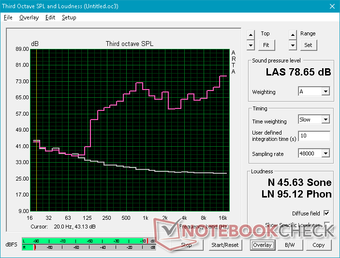
Asus VivoBook S15 S532F audio analysis
(±) | speaker loudness is average but good (78.7 dB)
Bass 100 - 315 Hz
(±) | reduced bass - on average 12.3% lower than median
(±) | linearity of bass is average (11.9% delta to prev. frequency)
Mids 400 - 2000 Hz
(+) | balanced mids - only 3.2% away from median
(±) | linearity of mids is average (8% delta to prev. frequency)
Highs 2 - 16 kHz
(+) | balanced highs - only 2.5% away from median
(±) | linearity of highs is average (9.4% delta to prev. frequency)
Overall 100 - 16.000 Hz
(±) | linearity of overall sound is average (18.9% difference to median)
Compared to same class
» 57% of all tested devices in this class were better, 8% similar, 35% worse
» The best had a delta of 5%, average was 17%, worst was 45%
Compared to all devices tested
» 43% of all tested devices were better, 8% similar, 49% worse
» The best had a delta of 4%, average was 24%, worst was 134%
Apple MacBook 12 (Early 2016) 1.1 GHz audio analysis
(+) | speakers can play relatively loud (83.6 dB)
Bass 100 - 315 Hz
(±) | reduced bass - on average 11.3% lower than median
(±) | linearity of bass is average (14.2% delta to prev. frequency)
Mids 400 - 2000 Hz
(+) | balanced mids - only 2.4% away from median
(+) | mids are linear (5.5% delta to prev. frequency)
Highs 2 - 16 kHz
(+) | balanced highs - only 2% away from median
(+) | highs are linear (4.5% delta to prev. frequency)
Overall 100 - 16.000 Hz
(+) | overall sound is linear (10.2% difference to median)
Compared to same class
» 7% of all tested devices in this class were better, 2% similar, 91% worse
» The best had a delta of 5%, average was 18%, worst was 53%
Compared to all devices tested
» 4% of all tested devices were better, 1% similar, 94% worse
» The best had a delta of 4%, average was 24%, worst was 134%
Energy Management
Power Consumption
Idling on desktop demands between 6 W and 11 W depending on the brightness and power profile. The ScreenPad demands an additional 2.8 W when at its maximum brightness setting. Results are slightly higher on average than the ZenBook 15 UX533FD and Acer Aspire 5 A515 during these low loads.
When gaming, consumption jumps to the 58 W to 69 W range to be more demanding than the aforementioned Acer. The ZenBook 15 UX533FD with more powerful GTX 1050 Max-Q graphics is only slightly more demanding at 74 W despite it offering 50 percent faster GPU performance than our GeForce MX250.
When running both Prime95 and FurMark simultaneously, consumption spikes to 88 W before declining to 70 W, 55 W, and then 50 W as shown by our graph below. This behavior mirrors our Stress Test observations above where clock rates are highest only during the first few seconds of testing before declining over time.
The small (~7.5 x 7.5 x 3.3 cm) 90 W AC adapter is just enough to power the system through high processing loads. Running 3DMark 06, for example, already draws 69 W on average.
It's worth noting that the system draws an unusually high >4 W when in Sleep mode and it appears to have issues entering a "true" sleep state because the bottom surface would always become very warm. Most laptops are at 2 W or less when under such conditions.
| Off / Standby | |
| Idle | |
| Load |
|
Key:
min: | |
| Asus VivoBook S15 S532F i7-8565U, GeForce MX250, WDC PC SN520 SDAPNUW-256G, IPS, 1920x1080, 15.6" | Dell XPS 15 9570 Core i9 UHD i9-8950HK, GeForce GTX 1050 Ti Max-Q, Samsung SSD PM981 MZVLB1T0HALR, IPS, 3840x2160, 15.6" | HP Envy x360 15-bq102ng R5 2500U, Vega 8, Samsung PM961 MZVLW256HEHP, IPS, 1920x1080, 15.6" | Lenovo Ideapad 720S-15IKB 81AC001AGE i7-7700HQ, GeForce GTX 1050 Ti Max-Q, Samsung SSD PM981 MZVLB512HAJQ, IPS, 1920x1080, 15.6" | Asus ZenBook 15 UX533FD i7-8565U, GeForce GTX 1050 Max-Q, WDC PC SN520 SDAPNUW-512G, IPS, 1920x1080, 15.6" | Acer Aspire 5 A515-52G-723L i7-8565U, GeForce MX250, WDC PC SN520 SDAPNUW-512G, IPS, 1920x1080, 15.6" | |
|---|---|---|---|---|---|---|
| Power Consumption | -44% | 31% | 8% | 14% | 23% | |
| Idle Minimum * (Watt) | 6 | 7.1 -18% | 4.8 20% | 3.7 38% | 2.7 55% | 4.4 27% |
| Idle Average * (Watt) | 10.3 | 13.6 -32% | 7 32% | 8 22% | 8 22% | 6.9 33% |
| Idle Maximum * (Watt) | 10.5 | 14.1 -34% | 9.5 10% | 9.8 7% | 10.6 -1% | 9.9 6% |
| Load Average * (Watt) | 69.1 | 103.9 -50% | 40.8 41% | 85 -23% | 74 -7% | 55 20% |
| Witcher 3 ultra * (Watt) | 57.8 | 103 -78% | ||||
| Load Maximum * (Watt) | 88 | 130.9 -49% | 44.3 50% | 92.4 -5% | 89 -1% | 63.4 28% |
* ... smaller is better
Battery Life
Battery capacity has not changed from the last generation VivoBook S15 S530. As a result, battery life is shorter since there are now two displays to power. We are able to record a runtime of just over 5 hours compared to almost 6.5 hours on the S530 when under similar WLAN conditions. Similar battery life discrepancies were also recorded between the ZenBook UX580 and UX550. Most other 15.6-inch Ultrabooks have larger batteries for noticeably longer runtimes including Asus' own ZenBook 15 UX533.
Charging from empty to full capacity takes about 1.5 hours.
| Asus VivoBook S15 S532F i7-8565U, GeForce MX250, 42 Wh | Dell XPS 15 9570 Core i9 UHD i9-8950HK, GeForce GTX 1050 Ti Max-Q, 97 Wh | HP Envy x360 15-bq102ng R5 2500U, Vega 8, 55.8 Wh | Lenovo Ideapad 720S-15IKB 81AC001AGE i7-7700HQ, GeForce GTX 1050 Ti Max-Q, 79 Wh | Asus ZenBook 15 UX533FD i7-8565U, GeForce GTX 1050 Max-Q, 73 Wh | Acer Aspire 5 A515-52G-723L i7-8565U, GeForce MX250, 48 Wh | Asus VivoBook S15 S530UN-BQ097T i5-8550U, GeForce MX150, 42 Wh | |
|---|---|---|---|---|---|---|---|
| Battery runtime | 26% | 39% | 73% | 107% | 32% | 27% | |
| Reader / Idle (h) | 10.9 | 15 38% | 22.6 107% | 26.5 143% | 12.9 18% | ||
| WiFi v1.3 (h) | 5.1 | 8.6 69% | 7.1 39% | 9.8 92% | 8.7 71% | 6.9 35% | 6.5 27% |
| Load (h) | 1.4 | 1 -29% | 1.7 21% | 2.9 107% | 2 43% |
Pros
Cons
Verdict
In our review of the original ZenBook Pro 15 with ScreenPad 1.0, we called it an inherently useful innovation but with plenty of first-generation problems like the steep learning curve, clunky UI, very grainy display, and reduced battery life. ScreenPad 2.0 directly alleviates many of our complaints with its larger size, brighter touchscreen, and revised Android-like UI for a laptop that's just half the price of the ZenBook Pro 15. It's common for users to skip first generation products because the second generation models will almost always be significantly better and cheaper. This school of thought couldn't apply more to the ScreenPad 2.0; If you were intrigued by the Asus technology but decided to wait it out last year, then this year's affordable VivoBook is the time to finally jump in.
ScreenPad 2.0 is by no means perfect. The matte overlay is still on the grainy side especially when compared to the crisp glossy smartphone displays in our pockets. The extra screen continues to impact battery life and Windows itself is not well optimized for such a high PPI display in the first place. Perhaps a ScreenPad that matches the native resolution, contrast, and colors of the main display would have created better synergy between them.
As for the laptop itself, the CPU is slower than average because of its limited Turbo Boost sustainability. This thankfully does not impact gaming performance which makes this VivoBook a good solution for both productivity and casual gaming purposes.
The ScreenPad isn't a novelty for the sake of being different. It's aspect ratio and innate second monitor properties make it objectively more useful that Apple's Touch Bar approach. There are still lots of kinks to work out especially in regard to graininess, but it's a huge leap forward in the right direction over last year's ScreenPad 1.0.
Asus VivoBook S15 S532F
- 07/23/2019 v6 (old)
Allen Ngo




